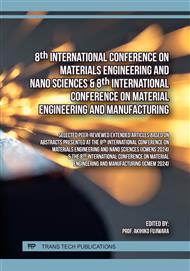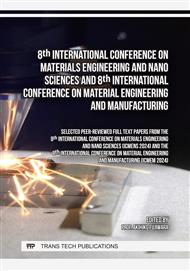[1]
Y. Mao, Z. Ding, C. Yuan, S. Ai, M. Isakov, J. Wu, T. Wang, M.L. Dunn, H.J. Qi, 3D Printed Reversible Shape Changing Components with Stimuli Responsive Materials, Scientific Reports. 6 (2016).
DOI: 10.1038/srep24761
Google Scholar
[2]
H. Eng, S. Maleksaeedi, S. Yu, Y.Y.C. Choong, F.E. Wiria, R.E. Kheng, J. Wei, P.C. Su, H.P. Tham, Development of CNTs-filled photopolymer for projection stereolithography, RapidPrototyping Journal.23(2017)129–136.https://doi.org/10.1108/RPJ-10-2015- 0148.
DOI: 10.1108/rpj-10-2015-0148
Google Scholar
[3]
J.R. Tumbleston, D. Shirvanyants, N. Ermoshkin, R. Janusziewicz, A.R. Johnson, D. Kelly, K. Chen, R. Pinschmidt, J.P. Rolland, A. Ermoshkin, E.T. Samulski, J.M. DeSimone, Continuous liquid interface production of 3D objects, Science. 347 (2015) 1349–1352.
DOI: 10.1126/science.aaa2397
Google Scholar
[4]
Y.Y.C. Choong, S. Maleksaeedi, H. Eng, S. Yu, J. Wei, P.C. Su, High speed 4D printing of shape memory polymers with nanosilica, Applied Materials Today. 18 (2020).
DOI: 10.1016/j.apmt.2019.100515
Google Scholar
[5]
A. Sun, X. He, X. Ji, D. Hu, M. Pan, L. Zhang, Z. Qian, Current research progress of photopolymerized hydrogels in tissue engineering, Chinese Chemical Letters. 32 (2021) 2117–2126.
DOI: 10.1016/j.cclet.2021.01.048
Google Scholar
[6]
H. Quan, T. Zhang, H. Xu, S. Luo, J. Nie, X. Zhu, Photo-curing 3D printing technique and its challenges, Bioactive Materials. 5 (2020) 110–115.
DOI: 10.1016/j.bioactmat.2019.12.003
Google Scholar
[7]
A. Bagheri, J. Jin, Photopolymerization in 3D Printing, ACS Applied Polymer Materials. 1 (2019) 593–611.
DOI: 10.1021/acsapm.8b00165
Google Scholar
[8]
Wang, Y., Blache, R., & Xu, X. (2017). Selection of additive manufacturing processes. Rapid Prototyping Journal, 23(2), 434–447.
DOI: 10.1108/rpj-09-2015-0123
Google Scholar
[9]
Mohsen, N. M., Craig, R. G., & Filisko, F. E. (1998). Effects of curing time and filler concentration on curing and postcuring of urethane dimethacrylate composites: A microcalorimetric study. Journal of Biomedical Materials Research, 40(2), 224–232. doi:10.1002/(sici)1097-4636(199805)40:2<224::aid-jbm7>3.0.co;2-n.
DOI: 10.1002/(sici)1097-4636(199805)40:2<224::aid-jbm7>3.3.co;2-i
Google Scholar
[10]
Sideridou, I. D., & Achilias, D. S. (2005). Elution study of unreacted Bis-GMA, TEGDMA, UDMA, and Bis-EMA from light-cured dental resins and resin composites using HPLC. Journal of Biomedical Materials Research Part B: Applied Biomaterials, 74B(1), 617–626.
DOI: 10.1002/jbm.b.30252
Google Scholar
[11]
Lempel, E., Czibulya, Z., Kovács, B., Szalma, J., Tóth, Á., Kunsági-Máté, S., Böddi, K. (2016). Degree of Conversion and BisGMA, TEGDMA, UDMA Elution from Flowable Bulk Fill Composites. International Journal of Molecular Sciences, 17(5), 732.
DOI: 10.3390/ijms17050732
Google Scholar
[12]
Guerra, R. M., Duran, I., & Ortiz, P. (2008). FTIR monomer conversion analysis of UDMA-based dental resins. Journal of Oral Rehabilitation, 23(9), 632–637.
DOI: 10.1111/j.1365-2842.1996.tb00903.x
Google Scholar
[13]
R.N. Jones, "Infrared Spectra of Organic Compounds: Summary Charts of Principal Group Frequencies", NRC Bulletin, [6], 1959.
Google Scholar
[14]
Zare, Y., & Rhee, K. Y. (2020). Simulation of Young's modulus for clay-reinforced nanocomposites assuming mechanical percolation, clay-interphase networks and interfacial linkage. Journal of Materials Research and Technology, 9(6), 12473–12483.
DOI: 10.1016/j.jmrt.2020.08.097
Google Scholar
[15]
Savage, D., Wilson, J., Benbow, S., Sasamoto, H., Oda, C., Walker, C., … Tachi, Y. (2019). Natural systems evidence for the effects of temperature and the activity of aqueous silica upon montmorillonite stability in clay barriers for the disposal of radioactive wastes.
DOI: 10.1016/j.clay.2019.105146
Google Scholar
[16]
Nguyen, J.-F., Pomes, B., Sadoun, M., & Richaud, E. (2019). Curing of urethane dimetracrylate composites: A glass transition study. Polymer Testing, 80, 106113. doi:10.1016/j.polymertesting. 2019.106113.
DOI: 10.1016/j.polymertesting.2019.106113
Google Scholar



